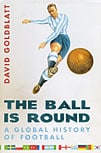 A Global History of Football
A Global History of Football
by David Goldblatt
Penguin/Viking, £30
Reviewed by Steve Roser
From WSC 245 July 2007
David Goldblatt’s new book weighs in at 3lb 8oz – three-and-a-half times the regulation ball weight established in the first revision of the laws of the game in 1872, but probably about the same mass as the sodden leather bladder that Nat Lofthouse used to head home. Very little has changed in the size and weight of the ball since then (an odd ounce in 1937), although technology, fashion and utility mean the modern ball is a different beast. In many ways the attraction of football is the enduring simplicity and coherence of the laws echoing those governing the ball, and the room that leaves for self-expression on a personal and team level. Goldblatt draws together all aspects of the game’s development into a terrific set of stories and insights, from tiny detail to sweeping generalisation, that well repays the potential upper body strain of lifting the thing.
The book starts with a wide-ranging review of sports in the ancient world, from the Aztec use of rubber balls in the tchatali game to The Odyssey, but moves quickly to the traditional Shrovetide brawls between villages, stressing the deep roots that the physical, passing game has in Britain. From then on Goldblatt knits his themes together using the politics and sociology of the time and above all economics, which in its various guises is the villain of the piece. Scattered through the book are short match reports – great games, horrible tragedies, pivotal political events. In the end, though, it is the player on the pitch that counts – there are some fine and stirring descriptions of personalities and games, highlighting the magic balances between the gifted player who can turn a World Cup (such as El Pibe d’Oro in 1986) and team organisation and strength such as the “anti-football” approach of the 1970s.
Where the book is really strong is showing the diversity of the game across the world. The section on Latin America is wonderful, reflecting the beauty, tragedy and diversity of that continent – you’re shown beyond the tricksy individuals in the favelas to a Brazil driven by a clear vision of what football should be. You can also begin to understand how it must have been to see the 1953 Hungarians in their fancy shoes stuff stuck-in-the-mud England and how history, politics and class leads English (but not Scottish) football to an overemphasis on physicality and hoofing the ball to a gangling 6ft 7in centre-forward. Goldblatt can’t expect to be on Christmas present lists for FIFA or UEFA as the greed and venality of the oligarchs and cadres of world football are laid bare; a detailed account of how cash was unlocked in Europe in the 1990s serves to demonstrate that, in the wake of David Beckham’s LA deals, a lot of folk will make a lot of money if football can get going in the US. The Ball is Round is tough going at times, partly because of its length, but well worth it for those who want to know how football got to where it is now, and where it could be heading in the future.